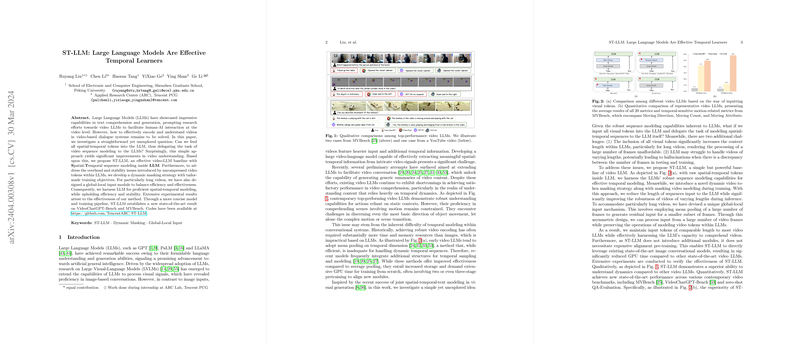Insights into "ST-LLM: LLMs Are Effective Temporal Learners"
The paper "ST-LLM: LLMs Are Effective Temporal Learners" addresses the challenging task of spatial-temporal modeling for video understanding. The researchers propose a novel approach using LLMs to model spatial-temporal tokens directly, marking a distinct shift from traditional methods that rely heavily on video encoders prior to input into LLMs.
Key Contributions and Methodologies
- Spatial-Temporal Token Integration: The core proposition of the paper is the integration of all visual tokens derived from frames of a video into the LLM. This approach leverages the innate sequence modeling capabilities of LLMs, thereby assigning them the task of spatial-temporal sequence understanding. By foregoing separate video encoders, the model simplifies the architecture while presumably improving the temporal discourse capabilities of the LLM.
- Dynamic Masking Strategy: To address lengthy video sequences, which can overwhelm the LLM’s capacity, the authors introduce a dynamic masking strategy. This method varies the masking rate during training, improving robustness to variations in input sequence length during inferential tasks. The technique also reduces the computational overhead traditionally associated with processing extensive sequences.
- Masked Video Modeling (MVM) Loss: The MVM loss plays a critical role by reconstructing unmasked tokens, which augments the LLM's predictive power over spatial-temporal dependencies. This innovative approach underscores the versatility of LLMs in tasks typically reserved for specialized video models.
- Global-Local Input Mechanism: For extended video inputs that present scalability issues, the paper proposes a global-local input methodology. This differential treatment of long-form content involves pooling for a global video representation and sparse local frame sampling, effectively balancing comprehensive context understanding with efficiency.
Empirical Validation and Comparative Analysis
The empirical analysis conducted within the paper demonstrates superior performance on various benchmarks such as MVBench and VideoChatGPT-Bench. Notably, the ST-LLM sets a new state-of-the-art on these tests, especially in terms of understanding temporal dynamics and motion-related content, areas where existing models exhibit significant deficiencies.
- Efficiency and Robustness: Despite the improvements in modeling complexity and capability, ST-LLM is reported to require less GPU time compared to its predecessors, attributed to its streamlined architecture and dynamic strategies to handle tokens.
- Comparative Superiority: The paper highlights ST-LLM's remarkable lead on tasks related to motion dynamics and temporal understanding, outstripping traditional methods like VideoChat2, especially amidst varying frame setups. This capability indicates a promising advancement for temporal-sensitive AI applications.
- Interpretative Challenges and Future Projections: The paper does identify shortcomings in dealing with fine-grained spatio-temporal representations, due to the limitations of using CLIP as a video encoder. This pinpointed limitation prompts considerations for future research to explore enhanced encoding mechanisms or integration strategies in LLM-based video comprehension.
Implications and Theoretical Underpinnings
The introduction of joint spatial-temporal-text modeling expands the functional horizon of LLMs beyond classical textual tasks, asserting their potential within the multimodal learning domain. The implications of this research extend into practical applications such as enhanced video dialogue systems, real-time event detection, and more nuanced human-AI interaction frameworks. The paradigm shift towards treating LLMs as universal sequence modelers opens doors to future developments where LLMs could centrally handle multimodal processing tasks.
Conclusion
In summary, "ST-LLM: LLMs Are Effective Temporal Learners" contributes significantly to the landscape of multimodal AI, offering a distinct methodology to harness LLM capabilities for intricate video understanding tasks. As the field advances, the insights and methodologies proposed could serve as a cornerstone for developing more efficient and effective multimodal processing systems.
